Story by Beth Sarafraz; Photos courtesy of the Lieber family

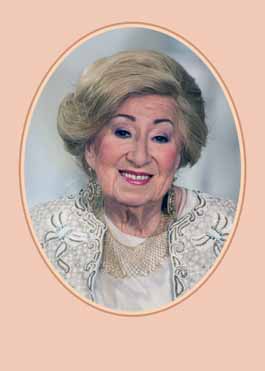
BROOKLYN, New York — When Lola Lieber’s husband, Mechel, was arrested by the Nazis during the Holocaust, she did the unthinkable. Posing as a Gentile, she walked into the Gestapo headquarters and asked to speak to whoever was in charge.
She told the receptionist that she had an appointment with SS Lieutenant-Colonel Adolf Eichmann, Gestapo Chief and overseer of Hitler’s Final Solution — the extermination of European Jewry. She was dressed to kill and the clerk probably thought that Eichmann had an interest in seeing her.
Confronting the infamous number two Nazi — whom she later said looked like a mild-mannered accountant — she told him her husband was not a Jew and had been picked up by accident, arrested by mistake. Eichmann picked up the phone to call the jail where Mechel was being held; it became obvious the ploy would not work. All the jailers would have to do to determine if a man was Jewish was check if he was circumcised.
Hearing Eichmann on the phone, she understood how badly things would play out. Lola turned and, as calmly as possible, began to stroll out the door, keeping up her pretense of innocence even while expecting a bullet in the back.
Miraculously, no one stopped her. Lola had displayed the truest love of all, vanquishing fear, when put to the harshest test. Soon after, Mechel successfully escaped and miraculously reunited with his beloved bride.
I met Lola in 2011, at a Yom HaShoah commemoration held at Brooklyn’s Yeshivah of Flatbush. She and her son, Hershel, seated on the stage, had a back-and-forth conversation under the spotlights about her years in Europe, running from the Nazis. The segments selected to discuss on that stage totally stunned the audience, myself included.
She was only 15 when the Nazis burst into the apartment building in Krakow, Poland, where she lived at that time, with her family. Going door to door, the uniformed jack-booted German soldiers terrorized families. At one point in the terrifying episode, Lola watched as one Nazi picked up an infant by its feet and swung it into a door, whereupon its head was smashed open.
Yet, Lola was a fearless woman who survived the Holocaust. At the time of her death in 2014 at the age of 91, she was the mother of three, grandmother of 12, great-grandmother of 50, great-great-grandmother of four, a successful artist, and author of A World After This: A Memoir of Loss and Redemption.
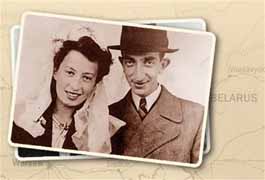
The book’s title came from something her husband told her on their wedding day. She was barely 18 when she married Mechel Lieber in a wartime, low-key, poor bride wedding. The 1941 ceremony was held in a rabbi’s backyard, in a little Polish town called Niepolomice.
A bed sheet covered the table; there was no wedding gown for the bride. The family gave money to a peasant to purchase duck for the wedding dinner, but he spent it all getting drunk in a bar. The family then paid a fishmonger to obtain the main course, but instead of purchasing fish for the feast, he disappeared — likely under the bar stool next to the duck dealer. In the end, a relative cooked up sour eggs for a main course.
Even more depressing — for an Orthodox Jewish girl — the wartime setting of utter destitution meant she had to marry without a minyan, outside of a shul. After the wedding, the bride wept until her young husband answered her in a way that proved him wise, tender, and compassionate beyond his years.
“We will survive this era. It is temporary. There will be a world after this,” said Mechel Lieber. “And, if we don’t survive — G-d forbid — but if we do not, at least, Lola, at least we have been married.”
The Nazis were savage predators fixated on hunting down unarmed innocents who ran and hid in homemade bunkers, like Mechel’s family. After one particularly vicious hide-and-seek raid, Lola and Mechel found them all shot to death in the bunker where they had been hiding from the Nazis.
Risking discovery and certain death, the couple loaded the bodies into a wheelbarrow and transported them to the town’s Jewish cemetery.
There, the young couple dug out the frozen earth until their hands bled, in order to bury them together. One of the victims, a little girl who was her husband’s sister, died holding a doll in her hand. Lola buried the child still clutching the doll. They paused to whisper the Kaddish prayer for the dead, while also praying the soldiers of the Reich would not discover them performing this “illegal” final act of decency and holiness. Miraculously, they were not caught.
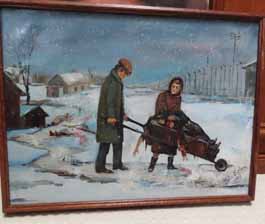
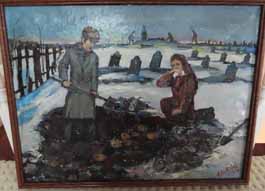
Years later, Lola painted two horrifying pictures of that event: “Bochnia: On the Way to the Cemetery” and “Bochnia: Burying the Dead.” In the first, a grief-stricken Mechel with head hanging pushes a wheelbarrow piled with bodies, lifeless arms hanging off the sides, with Lola trying to keep them from falling out. In the second, like the next frame in a film, the bodies of murdered family members are lying face up in a homemade grave. Mechel is frozen in time holding up a shovelful of earth to cover them over. Lola sits on the frozen ground covering her mouth, silencing a scream.
No photograph of that tragic scene exists, but the paintings suggest that Lola went outside herself that day — spiritually — to view herself, Mechel, and the corpses of beloved family members under a bleak, gray, freezing Polish sky.
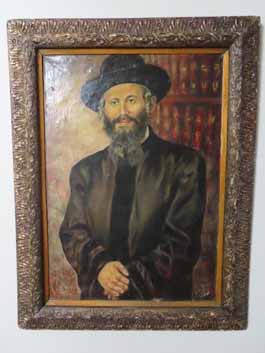
Lola went on to save the esteemed Bobover Rebbe Halberstam and his entire family from imminent death at the hand of the Nazis in Poland’s Bochnia ghetto. There, the German Commander Schomburg offered her safe passage out of the killing zone because she was able to convince him, by chatting about goulash, pastries and a popular Hungarian song, that she was from Munkach in Hungary and thus not subject to Nazi decrees in Bochnia.
However, instead of seizing this gift of life and running with it, she requested permission to take all of her relatives with her, assuring the Nazi that every last one of them was from Hungary and therefore, also exempt. Miraculously, he gave permission for all of them to leave. That night, Lola forged birth certificates for her entire family, plus “extended” members — the Bobover Rebbe and his family, insuring their safe passage out of doomed Bochnia. For this selfless act, the Rebbe was grateful to the core of his being, calling Lola a “modern day Queen Esther.”
In Budapest, with Russians soldiers pouring into that city, the war was supposed to be over, or so Mechel and Lola thought. In the days leading up to Liberation, Lola was starving and very ill. Someone who had found precious noodles and boiled them in water, offered the leftover water to Lola. She drank it and was grateful. She did not curse the person who withheld the noodles from her. Even at the point of death, the essence of her being whispered, “Gam zu l’tova (this too is for the good).”
But the Russians had scores to settle with their enemies. Conquering Russian soldiers mistakenly thought that Lola and Mechel were German spies and forced the couple up against a wall, ordering them to put their hands up, and trained their machine guns on them.
A moment before the firing began, Lola and Mechel looked up to Heaven. “We started to scream Shema Yisrael and waited for the shots,” said Lola. But then a miracle occurred. At that very moment, another Russian soldier — who understood Hebrew and who was “coincidentally” passing by — screamed even louder, “Don’t kill them! They’re Jews!”
Thus, the Liebers survived the war. In January 1946, Lola gave birth to their first child, Hershel, in a Munich hospital. “I was a celebrity,” says Hershel about the circumstances of his birth — a Jewish baby born on German soil. He had a brit milah (circumcision) and a pidyon haben (redemption of the first-born) attended by American Jewish soldiers stationed in Germany.
Meanwhile they waited for their visas. Luckily, Mechel had family members in Williamsburg, Brooklyn — the American Liebers, who ran a well-known chocolate manufacturing company. These good people pledged to be financially responsible for their surviving family members who arrived in New York in 1947, leaving Munich on the military-type cargo ship, the S.S. Ernie Pyle.
Mechel went to work as a hosiery salesman, selling nylon stockings instead of the pre-war silk ones. Two more children, Yossi and Mati, were born. Hershel remembers these as happy years, especially at their Passover seders. “Of course we read the Haggadah, recalling the Jewish Exodus out of bondage in Egypt. But over the dinner, my mother and father told the stories of their own flight to freedom,” from the blood-soaked graveyard of Nazi Europe to America, home of liberty and justice for all — including Jews.
Happily ever after ended in 1966, when Mechel died of cancer. With the heroic young husband of her dreams gone, Lola mourned greatly, but then she did what survivors do — she remarried. Twice.
She also painted fast and furiously — “over 1,500 paintings” according to Hershel. “About 10-12 of them were Holocaust themed and of these, four went to Yad Vashem in Israel.” She also painted flower-filled landscapes. “But her specialty,” says Hershel, “was doing portraits. She painted all the rebbes – the Bobover, the Belzer, the Gerer, the Lubavitcher, and both Satmar rebbes.”
Then Hershel talked her into writing a book. “I grew up hearing her stories and my father’s stories at the seders — about pre-war, during-war, after-war. I encouraged her to set down these stories in writing. She began recording them and we found an editor to pull it all together into a book, published in 2010.”
Lola was 87 years old when the book came out. “It was the harbinger of a whole new thing — going to schools to speak about the Holocaust,” recalls Hershel. Lola gave these talks at Bais Yaakov schools in Los Angeles, Miami, and Brooklyn, at Brooklyn’s Yeshiva of Flatbush, and at Kingsborough College — the latter with its student body comprised of Gentiles and Jews.
At first Hershel recalls “she was petrified.” But then, seeing all those young people rapt with attention hanging on her every word she relaxed, understanding she was handing over the history of a generation, speaking
for all those murdered Jews who could not speak for themselves. She was bearing witness.
Lola passed away on the ninth of Cheshvan, the same yahrzeit as Mechel — on the 48th anniversary of his death. “The chances for that to happen are one in about 350, going by the Jewish calendar,” says Hershel.
Her daughter, Mati Jacobovits, explained to me the hidden meaning behind such an unlikely occurrence. “They say your neshama, your soul, comes down to the world on your yahrzeit. Friday morning, my mother was ill in the hospital, but the rest of us went to the cemetery to pray at my father’s grave. We knew he was ‘in the neighborhood’ because his yahrzeit was the next day. We asked him to help our mother, because she was suffering. We left and went home to make Shabbos. Our mother died motzei Shabbos,” Mati said, with a catch in her voice. “I think my father — her beloved husband — decided she’d had 91 years and maybe that was enough; maybe it was time to come home with him.”
“Her legacy,” says her oldest son, “is not only about her Holocaust experiences, nor her talent as an accomplished artist. She was a loving, giving, caring woman. There wasn’t a person who met her who didn’t fall in love with her.”
She was someone “who saw that everything comes from G-d,” her daughter-in-law, Pesi Lieber, had told me after the 2011 Yom HaShoah presentation. She was a survivor who believed it was important to speak out about the Holocaust “to make sure it won’t happen again,” her other daughter-in-law, Idii Lieber, added.
In summing up her thoughts after completing the unique, compelling, emotionally wrenching presentation that night, Lola had said: “Cherish your parents and siblings and children. It’s terrible to lose everybody.”
Watching the stunned, tearful men and women in the audience file out that night, slowly processing in their minds the unspeakable horrors spoken of by a mother and son, on that specially designated day for remembering the murder of six million Jews, the last thing Lola Lieber said to me was, “Let’s hope it will never happen again.”
*
This article appeared initially in The Jerusalem Herald. Beth Sarafraz is a freelance writer living in Brooklyn, New York. Click here to read more of this writer’s work in The Jerusalem Herald.